Being Certan
It’s November and the end of the ‘bee season’ is well and truly here. Inspections finished some time ago (or should have) and the winter Varroa treatments are completed (or should be).
Preparation for the coming season should now be the priority. One of the first things that needs to be done is protecting any valuable drawn comb not covered with bees.
Drawn comb is a really precious resource and is well worth looking after carefully. All beekeepers are likely to have super frames of drawn comb after honey extraction. Some will additionally have drawn brood frames. Finally, beekeepers who do a lot of queen rearing may have drawn frames of drone comb. All can be re-used, in the case of super frames many, many times, so saving the bees the effort (and the nectar used) to draw fresh comb.
Super frames
I allow the bees to clean out super frames from which the honey has been extracted. I place them back on the hive in the evening and the bees clean out the traces of honey. After clearing them again I stack them outdoors carefully on a plastic or Correx ‘floor’ and a wasp-proof roof. Sometimes – though not every year due to forgetfulness – I treat them with acetic acid to kill Nosema spores. I’ll discuss this in a future post as I’ll be doing it this season. If I remember.
I’ve got super frames dating back to my first year of beekeeping that are still perfectly usable. Any with odd-shaped comb just get sliced back square to the sidebars with a breadknife.
Any which has had brood reared in it (for example, when the queen sneaks above the excluder, or I’ve run a colony as ‘brood and half’, both increasingly rare events) goes into the steam wax extractor.
Brood frames
Spare brood frames are a great thing to have at hand when making up nucleus colonies, during queen rearing or at a variety of other times. They deserve to be protected and stored properly.
Unless, of course, they’ve had more than about three years of use, in which case they are also usually rendered down in the steam wax extractor. Even these old ones sometimes get a reprieve. I give them one more season as the single frame of old brood comb in my bait hives. These manky old frames should also be treated with acetic acid to kill Nosema spores and protected and stored carefully.
Galleria mellonella and Achroia grisella
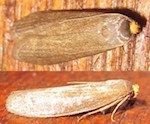
Lesser wax moth (12mm)
These are respectively the greater and lesser wax moth. They infest stored comb and favour brood comb with old cocoons, traces of pollen and larval faeces. If unchecked they can destroy your valuable comb, converting the lovely wax to a mass of silk-lined tunnels and dust. They much prefer brood comb to super comb and seem to avoid supers stored ‘wet’ i.e. extracted but not subsequently cleaned by the bees.
It’s difficult, but not impossible, to provide moth-proof storage for your comb. They can sneak through a surprisingly narrow gap in the joint of a brood box.
In early copies of Hooper’s Guide to Bees and Honey it was recommended to use paradichloro-benzene (or, more correctly, 1,4-dichlorobenzene) to protect your brood frames from the ravages of wax moths. This is the stuff that makes moth balls stink. It’s pretty unpleasant, potentially neurotoxic (for humans) and not something I want anywhere near my ‘honey for human consumption’ bees.
I’ve not got a current copy of Hooper, so don’t know what is recommended now, but there are much better alternatives.
Biological control
Wax moths lay their eggs in stored frames, the eggs hatch and the larvae (caterpillars) burrow through the wax, eating their way through the old cocoons and other rubbish, creating a huge network of silken tunnels which eventually trash the comb. They then pupate and subsequently emerge as moths to fly off and decimate more stored comb. Little blighters!
It’s the ‘eating’ in the paragraph above that makes them susceptible to biological control with Bacillus thuringiensis.
Bacillus what?
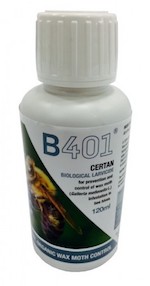
B401 Certan
Bacillus thuringiensis is a bacterium. During its replication it generates spores and a so-called crystal protein that is lethal to the moth larvae in which it is replicating. I’ll return to the spores later … these are a thermally and environmentally stable form of the bacterium, protected by a thick cell wall.
The crystal protein (or, more correctly, δ-endotoxin) dissolves in the alkaline environment of the insect gut, thereby making it susceptible to digestion by proteases present in the gut. This protease cleavage releases the active form of the toxin which inserts into the cells of the gut, paralysing the cells and finally resulting in the formation of a pore.
This isn’t good for the moth larva. Not good at all. Actually, it’s probably a rather grisly end for the moth but, having seen the damage they can do to stored comb, my sympathy is rather limited.
However, it’s very good news for the beekeeper. It’s particularly good because of the specificity of the toxin (which is often referred to as Bt-toxin). The vast majority of Bt-toxins used for biological control are specific for the larvae of the lepidoptera – the butterflies and moths. These have no activity against bees or other pollinators.
Since the only moth or butterfly larvae that occur in hives, or on stored comb, are the unwanted wax moths, this is an effective and safe way of preventing infestations.
Preventing, not curing. Once infestation is present the damage is largely done.
Biological control is compatible with organic farming methods, if that’s what floats your boat.
Certan
B401 Certan† is the most commonly available and regularly used Bt-toxin for beekeepers. You can buy Certan from the majority of beekeeping suppliers. Certan is supplied in bottles containing the spores or protein toxin of Bacillus thuringiensis subspecies aizawai. You make it up in water and spray it onto both faces of the drawn comb you want to protect from wax moths.
Certan costs about £16 a bottle which is sufficient to treat 120 brood frames (~13p/frame). Certan is used at a 1:20 dilution in water i.e. a 5% solution. Full details are available from Vita Bee Health who are distributors for Certan (no, they're not … approval withdrawn, no longer available). There’s a nice video on the Vita site which shows how easy it is to administer.
DiPel DF
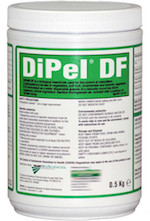
DiPel DF
As an alternative to Certan, some beekeepers use DiPel DF. This contains the kurstaki subspecies of Bacillus thuringiensis. Although a different subspecies, the toxin is equally effective and equally specific. DiPel DF is widely available from agricultural suppliers and costs about £55 for 500g. DiPel DF sourced from Italy is routinely listed on eBay at a much lower price.
Because DiPel DF isn’t specifically sold for beekeepers the recommended dilution to be used isn’t published. However, if you grow tomatoes under cover the recommended dose is 100g per 100 litres of water i.e. a 0.1% solution.
I’ve used DiPel DF at a 1% concentration. I mixed the powder thoroughly 1 part in 20 and then used this stock solution 1:5 to make the working-strength solution to be sprayed onto the frames. About 10 ml per side per frame is used, sprayed with a fine nozzle. At this dilution, DiPel DF costs about 2p per frame … a very considerable saving. It may be equally effective at 0.1% – I’ve not tried – in which case it would obviously be even more economical.
DiPel is listed as non-toxic for bees and it’s certainly effective against wax moth.
A pressurised hand sprayer works well to administer DiPel or Certan. You can usually get these sprayers from big supermarkets for a couple of pounds.
Spores store
The beauty of spores is that they’re very stable. This means you can store them for long periods without them ‘going off’. Neither Certan or DiPel DF make absolutely clear what the bottle contains – sometimes they refer to ‘active protein’, sometimes to ‘toxin’ and sometimes to Bacillus thuringiensis. Some even suggest a mix … Valent BioSciences, the manufacturer of DiPel DF claim that it contains an optimized blend of four potent Bt protein toxins and a spore. They should know. The DF suffix means ‘dry flowable’ by the way.
Whatever is actually in the bottle, it’s pretty stable. If you store the powder in a cool, dry, frost-free location it should be OK for several years. The safety data sheet for Certan states that it remains active for at least 5 years if stored unopened at 5°C or less.
Store frames
The Certan or DiPel-treated frames should be stored, dry, in empty brood or nucleus boxes. These are best stacked outside, protected from rain or being blown over, until they’re needed next season.
Which is a long way off, but slowly getting closer …
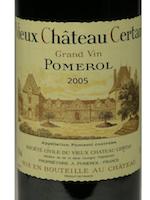
Hic!
† Certan is also a well known and respected Bordeaux wine from the appellation Pomerol. The full name is Château Certan de May de Certan, which is both a bit of a mouthful and internally redundant. The middle ‘de May’ part of the name is derived from the Demay family, the original owners, who were of Scottish origin and lived in France from the Middle Ages.
Make sure you buy the right Certan … whilst the stuff from Thorne’s is not inexpensive, a 2005 Vieux Château Certan will cost about £360 🙁 However, this is a bargain when compared with a similar aged Petrus (which shares the same clay soil on the right bank of the Gironde) at ten times the price.
Oh yes … these prices are per bottle 😯
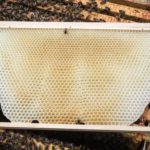
Join the discussion ...